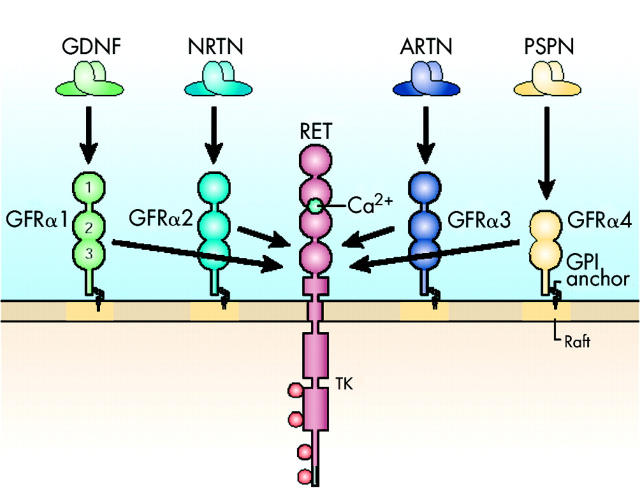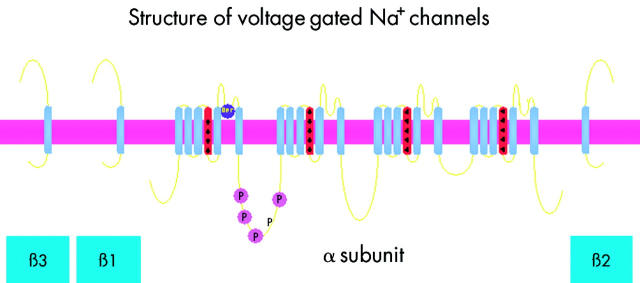Abstract
Thermal, mechanical, and chemical stimuli depolarise specialised damage sensing neurons to initiate electrical signals that may ultimately result in a sensation of pain. Over the past decade many of the receptors that transduce these signals have been identified by molecular cloning. In the absence of specific blockers, null mutant mice have proved valuable in exploring the function of these specialised receptors. As well as the mechanisms of signal transduction, the setting of thresholds for excitation and the transmission of electrical signals have also been the focus of intense interest. In vitro studies of dorsal root ganglion sensory neurons have thus facilitated rapid advances in our understanding of the biology of nociceptors. However, the specific properties of visceral afferents are poorly defined, and useful animal models of visceral pain are only now being developed. Visceral neuron receptor subtypes and the consequences of their activation in terms of pain perception and behaviour are thus subjects that still demand a major research effort.
Full Text
The Full Text of this article is available as a PDF (291.2 KB).
Figure 1 .
Cell signalling through the red tyrosine kinase by members of the glial derived neurotrophic factor family. The associated α subunits determine the specificity of the interaction between the various ligands GDNF (α-1), neurturin (α-2), artemin (α-3), and persephin (α-4). GFR, growth factor receptor; GPI, glycophosphoinositol.
Figure 2 .
Structure of a voltage sodium channel α subunit showing the voltage sensor S4 domains and the accessory subunits that anchor the channel with respect to extracellular signals.
Selected References
These references are in PubMed. This may not be the complete list of references from this article.
- Akopian A. N., Sivilotti L., Wood J. N. A tetrodotoxin-resistant voltage-gated sodium channel expressed by sensory neurons. Nature. 1996 Jan 18;379(6562):257–262. doi: 10.1038/379257a0. [DOI] [PubMed] [Google Scholar]
- Akopian A. N., Souslova V., England S., Okuse K., Ogata N., Ure J., Smith A., Kerr B. J., McMahon S. B., Boyce S. The tetrodotoxin-resistant sodium channel SNS has a specialized function in pain pathways. Nat Neurosci. 1999 Jun;2(6):541–548. doi: 10.1038/9195. [DOI] [PubMed] [Google Scholar]
- Baker Mark D., Chandra Sonia Y., Ding Yanning, Waxman Stephen G., Wood John N. GTP-induced tetrodotoxin-resistant Na+ current regulates excitability in mouse and rat small diameter sensory neurones. J Physiol. 2003 Mar 21;548(Pt 2):373–382. doi: 10.1113/jphysiol.2003.039131. [DOI] [PMC free article] [PubMed] [Google Scholar]
- Bielefeldt K., Ozaki N., Gebhart G. F. Experimental ulcers alter voltage-sensitive sodium currents in rat gastric sensory neurons. Gastroenterology. 2002 Feb;122(2):394–405. doi: 10.1053/gast.2002.31026. [DOI] [PubMed] [Google Scholar]
- Caterina M. J., Schumacher M. A., Tominaga M., Rosen T. A., Levine J. D., Julius D. The capsaicin receptor: a heat-activated ion channel in the pain pathway. Nature. 1997 Oct 23;389(6653):816–824. doi: 10.1038/39807. [DOI] [PubMed] [Google Scholar]
- Drew Liam J., Wood John N., Cesare Paolo. Distinct mechanosensitive properties of capsaicin-sensitive and -insensitive sensory neurons. J Neurosci. 2002 Jun 3;22(12):RC228–RC228. doi: 10.1523/JNEUROSCI.22-12-j0001.2002. [DOI] [PMC free article] [PubMed] [Google Scholar]
- Kellenberger Stephan, Schild Laurent. Epithelial sodium channel/degenerin family of ion channels: a variety of functions for a shared structure. Physiol Rev. 2002 Jul;82(3):735–767. doi: 10.1152/physrev.00007.2002. [DOI] [PubMed] [Google Scholar]
- Laird J. M., Martinez-Caro L., Garcia-Nicas E., Cervero F. A new model of visceral pain and referred hyperalgesia in the mouse. Pain. 2001 Jun;92(3):335–342. doi: 10.1016/S0304-3959(01)00275-5. [DOI] [PubMed] [Google Scholar]
- Laird Jennifer M. A., Souslova Veronika, Wood John N., Cervero Fernando. Deficits in visceral pain and referred hyperalgesia in Nav1.8 (SNS/PN3)-null mice. J Neurosci. 2002 Oct 1;22(19):8352–8356. doi: 10.1523/JNEUROSCI.22-19-08352.2002. [DOI] [PMC free article] [PubMed] [Google Scholar]
- McKemy David D., Neuhausser Werner M., Julius David. Identification of a cold receptor reveals a general role for TRP channels in thermosensation. Nature. 2002 Feb 10;416(6876):52–58. doi: 10.1038/nature719. [DOI] [PubMed] [Google Scholar]
- Nakamura F., Strittmatter S. M. P2Y1 purinergic receptors in sensory neurons: contribution to touch-induced impulse generation. Proc Natl Acad Sci U S A. 1996 Sep 17;93(19):10465–10470. doi: 10.1073/pnas.93.19.10465. [DOI] [PMC free article] [PubMed] [Google Scholar]
- Peier Andrea M., Moqrich Aziz, Hergarden Anne C., Reeve Alison J., Andersson David A., Story Gina M., Earley Taryn J., Dragoni Ilaria, McIntyre Peter, Bevan Stuart. A TRP channel that senses cold stimuli and menthol. Cell. 2002 Mar 8;108(5):705–715. doi: 10.1016/s0092-8674(02)00652-9. [DOI] [PubMed] [Google Scholar]
- Price M. P., McIlwrath S. L., Xie J., Cheng C., Qiao J., Tarr D. E., Sluka K. A., Brennan T. J., Lewin G. R., Welsh M. J. The DRASIC cation channel contributes to the detection of cutaneous touch and acid stimuli in mice. Neuron. 2001 Dec 20;32(6):1071–1083. doi: 10.1016/s0896-6273(01)00547-5. [DOI] [PubMed] [Google Scholar]
- Rugiero François, Mistry Mohini, Sage Dominique, Black Joel A., Waxman Stephen G., Crest Marcel, Clerc Nadine, Delmas Patrick, Gola Maurice. Selective expression of a persistent tetrodotoxin-resistant Na+ current and NaV1.9 subunit in myenteric sensory neurons. J Neurosci. 2003 Apr 1;23(7):2715–2725. doi: 10.1523/JNEUROSCI.23-07-02715.2003. [DOI] [PMC free article] [PubMed] [Google Scholar]
- Story Gina M., Peier Andrea M., Reeve Alison J., Eid Samer R., Mosbacher Johannes, Hricik Todd R., Earley Taryn J., Hergarden Anne C., Andersson David A., Hwang Sun Wook. ANKTM1, a TRP-like channel expressed in nociceptive neurons, is activated by cold temperatures. Cell. 2003 Mar 21;112(6):819–829. doi: 10.1016/s0092-8674(03)00158-2. [DOI] [PubMed] [Google Scholar]
- Suzuki Makoto, Mizuno Atsuko, Kodaira Kunihiko, Imai Masashi. Impaired pressure sensation in mice lacking TRPV4. J Biol Chem. 2003 Apr 13;278(25):22664–22668. doi: 10.1074/jbc.M302561200. [DOI] [PubMed] [Google Scholar]




